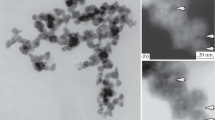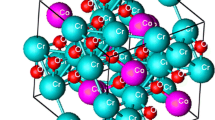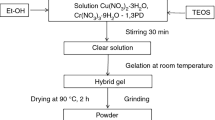Abstract
Cupric oxide (CuO) nanoparticles have been prepared in amorphous SiO2 matrix using a novel variant of sol-gel technique. The method is based on the polycondensation of a silica source (sodium silicate) in the presence of an aqueous solution containing complex of Cu(II) with polyvinyl alcohol (CuPVA). After gelation, polymeric complexes containing several thousands Cu atoms each are incorporated into the silica network forming a precursor, which is then annealed in oxygen to get rid of organic components. The formation of CuO nanoparticles was confirmed by electron diffraction studies. The size of nanoparticles can be controlled by varying [Cu2+]/[PVA] ratio in the precursor. Thus prepared CuO/SiO2 nanocomposites are characterized by high specific surface area as measured by capillary adsorption of nitrogen, suggesting their possible use in catalysis.
Similar content being viewed by others
Author information
Authors and Affiliations
Additional information
Received: 10 February 2000 / Reveiwed and accepted: 20 March 2000
Rights and permissions
About this article
Cite this article
Eliseev, A., Lukashin, A., Vertegel, A. et al. Complexes of Cu(II) with polyvinyl alcohol as precursors for the preparation of CuO/SiO2 nanocomposites. Mat Res Innovat 3, 308–312 (2000). https://doi.org/10.1007/PL00010877
Issue Date:
DOI: https://doi.org/10.1007/PL00010877




